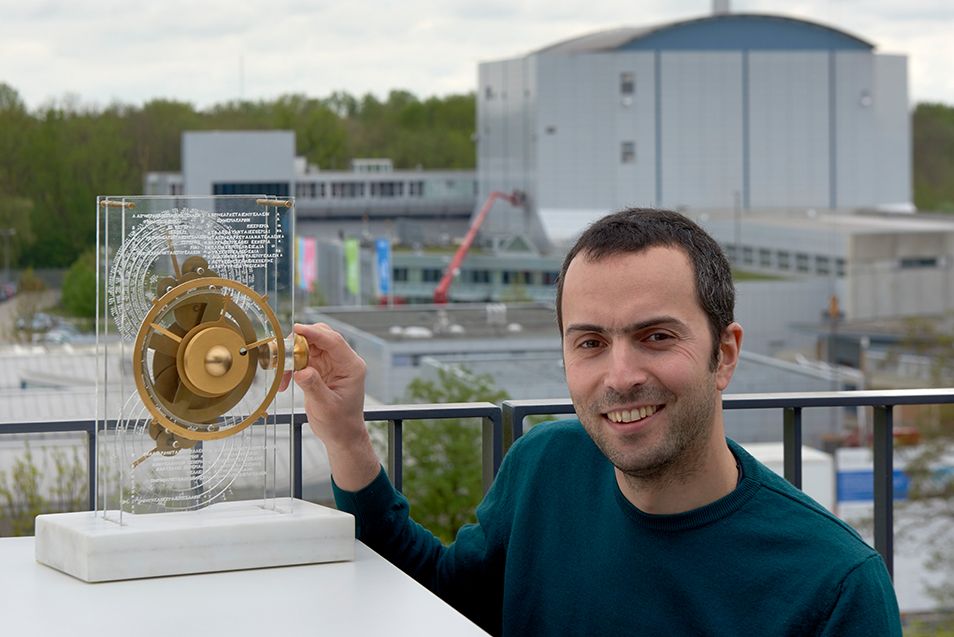MLZ is a cooperation between:
 > Technische Universität München
> Technische Universität München > Helmholtz-Zentrum Hereon
> Helmholtz-Zentrum Hereon
 > Forschungszentrum Jülich
> Forschungszentrum Jülich
MLZ is a member of:
 > LENS
> LENS > ERF-AISBL
> ERF-AISBL
MLZ on social media:

MLZ (eng)
Lichtenbergstr.1
85748 Garching
A 2000-year-old secret revealed

Markos Skoulatos, instrument scientist at the FRM II, recreated a functional Antikythera mechanism, as one of a few people worldwide. © W. Schürmann / TUM
The 2000-year-old antique computer has not let go of Markos Skoulatos ever since he watched a documentary on BBC in 2012. This rusty instrument that sponge-divers discovered in the sea in 1900 off the Greek island Antikythera is a one of a kind. However, until X-ray tomography data were collected in 2005, no one could decipher the mechanism [1-2].
“This astronomical calculating machine raised my researcher’s ambition” says the 35-year-old physicist at the Technical University of Munich. “I wanted to understand the Antikythera mechanism and make an exact replica.” For two years, Markos Skoulatos immersed himself in all the data and documents he could find about the fabled astronomical clock. At the time, he worked as a post-doc at the Paul Scherrer Institute in Switzerland, married and had two children. “I often sat over the papers at night when the family slept,” says Markos Skoulatos. After lots of calculations and modeling, he went to production and finally successfully assembled the “machine” in his basement.
“I wanted to show the beauty of the mechanism such that the people learn something”
In 2014, he presented a functional Antikythera mechanism, with only a handful of others available worldwide. “This project took me to a trip well worth it” says Markos Skoulatos, who is now instrument scientist at the three axes spectrometer MIRA of the Heinz Maier-Leibnitz Zentrum in Garching. And the charm of his model: The surrounding plexiglass allows the view of the mechanism inside. “I wanted to show the beauty of the mechanism such that my children and other people learn something when they look at the device” explains Skoulatos.
The Swiss company Hublot has even produced a watch containing the Antikythera mechanism, now on display next to the original Antikythera Mechanism. No inventor so far revealed the exact details of manufacturing, or posted a blueprint. “Markos Skoulatos documents and shares a lot of information at his website.
Now that Markos Skoulatos is working at the research neutron source, he would like to study the original with neutrons. “Neutrons would provide more valuable and complementary information, in combination with the previous X-ray measurements” he mentioned. Yet too fragile for a transport are the rusty findings, which are now exhibited at the National Archaeological Museum in Athens. The previous X-ray data collection took place directly in the museum.
The Antikythera mechanism is the first computer of humanity
The Antikythera mechanism is an astronomical calculator. It sunk together with a ship around 60 BC between the Greek Peloponnese and Crete. It is operated with a side handle that sets a date, and in the same time calculates a wealth of information about the sun and moon phase, planetary motion, solar or lunar eclipses and even Olympic Games and other events. That makes it the first “computer” of humanity. It is also a proof that ancient Greece was not only a leader in science and fine arts, but also in engineering and technology. The artifact contains what we now call a user manual, in terms of extremely detailed inscriptions engraved all over. Researchers suspect that the original was used in ancient times to teach astronomy.
Markos Skoulatos is continuing with his replica in this tradition of teaching and learning. On July 10, he gives a lecture about the Antikythera mechanism and how it works in detail, at the Munich State Antiquities Collection. He will also present his functional Antikythera mechanism. He currently updates it such that it can be controlled via WiFi from a smart phone/tablet, such that museum visitors can operate the astronomical calculator without touching the valuable parts.
[1] T. Freeth, Y. Bitsakis, X. Moussas, J. H. Seiradakis, A. Tselikas, H. Mangou, M. Zafeiropoulou, R. Hadland, D. Bate, A. Ramsey, M. Allen, A. Crawley, P. Hockley, T. Malzbender, D. Gelb, W. Ambrisco, M. G. Edmunds, Nature 444, 587 (2006).
[2] T. Freeth, A. Jones, J. M. Steele, Y. Bitsakis, Nature 454, 614 (2008).
The Antikythera mechanism as an app
Together with Georg Brandl, Markos Skouolatos has now implemented the Antikythera mechanism in the app “Eternal Gadgetry”. Users can play with the mysterious machine themselves and view planetary constellations or lunar and solar eclipses from the future as well as the past. More information about the app can be found here: https://www.eternalgadgetry.com/app.html.

Andrea Voit
Press & Public
Relations
FRM II
MLZ is a cooperation between:
 > Technische Universität München
> Technische Universität München > Helmholtz-Zentrum Hereon
> Helmholtz-Zentrum Hereon
 > Forschungszentrum Jülich
> Forschungszentrum Jülich
MLZ is a member of:
 > LENS
> LENS > ERF-AISBL
> ERF-AISBL
MLZ on social media:


